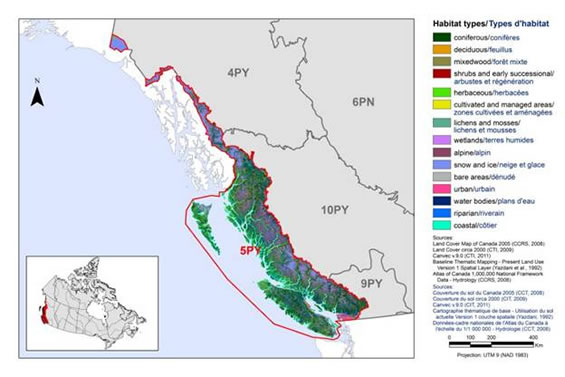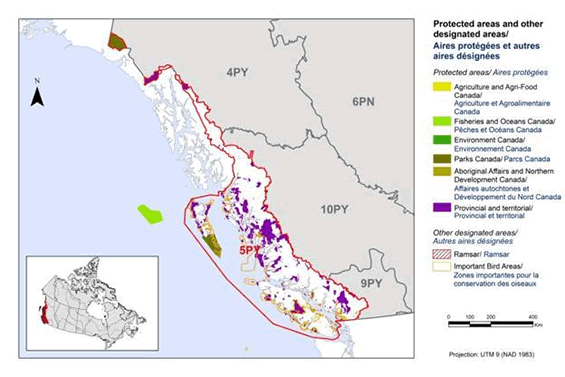Bird conservation strategy for region 5: Northern Pacific rainforest, chapter 5
Introduction: Bird Conservation Strategies
Context
This document is one of a suite of Bird Conservation Region Strategies (BCR strategies) that have been drafted by Environment and Climate Change Canada for all regions of Canada. These strategies respond to Environment and Climate Change Canada’s need for integrated and clearly articulated bird conservation priorities to support the implementation of Canada’s migratory birds program, both domestically and internationally. This suite of strategies builds on existing conservation plans for the four “bird groups” (waterfowl,Footnote 2 waterbirds,Footnote 3 shorebirds,Footnote 4 and landbirdsFootnote 5 in most regions of Canada, as well as on national and continental plans, and includes birds under provincial/territorial jurisdiction. These new strategies also establish standard conservation planning methods across Canada, and fill gaps, as previous regional plans do not cover all areas of Canada or all bird groups.
These strategies present a compendium of required actions based on the general philosophy of achieving scientifically based desired population levels as promoted by the four pillar initiatives of bird conservation. Desired population levels are not necessarily the same as minimum viable or sustainable populations, but represent the state of the habitat/landscape at a time prior to recent dramatic population declines in many species from threats known and unknown. The threats identified in these strategies were compiled using currently available scientific information and expert opinion. The corresponding conservation objectives and actions will contribute to stabilizing populations at desired levels.
The BCR strategies are not highly prescriptive. In most cases, practitioners will need to consult additional information sources at local scales to provide sufficient detail to implement the recommendations of the strategies. Tools such as beneficial management practices will also be helpful in guiding implementation. Partners interested in participating in the implementation of these strategies, such as those involved in the habitat Joint Ventures established under the North American Waterfowl Management Plan (NAWMP), are familiar with the type of detailed implementation planning required to coordinate and undertake on-the-ground activities.
Strategy structure
Section 1: Summary of Results - All Birds, All Habitats of this strategy presents general information about the BCR and the subregion, with an overview of the six elementsFootnote 6 that provide a summary of the state of bird conservation at the sub-regional level. Section 2: Conservation Needs by Habitat provides more detail on the threats, objectives and actions for priority species grouped by each of the broad habitat types in the subregion. Section 3: Additional Issues presents additional widespread conservation issues that are not specific to a particular habitat or were not captured by the threat assessment for individual species, as well as research and monitoring needs, and threats to migratory birds while they are outside of Canada. The approach and methodology are summarized in the appendices, but details are available in a separate document (Kennedy et al. 2012). A national database houses all the underlying information summarized in this strategy and is available from Environment and Climate Change Canada.
Characteristics of Bird Conservation Region 5: Northern Pacific Rainforest
BCR 5, the Northern Pacific Rainforest, extends from the western Gulf of Alaska south through British Columbia, Washington, Oregon, to northern California. In Canada, the terrestrial portion of BCR 5 is about 20.5 million hectares (ha) in extent, covering British Columbia from the coast inland though the Coast Mountains, and includes Vancouver Island and Haida Gwaii (Fig. 1). It also extends northwards inland of the Alaska panhandle and includes a small corner of extreme southwestern Yukon Territory. BCR 5 also encompasses the marine environment, from the coastline westward to the limit of Canada’s 200-nautical mile exclusive economic zone. In British Columbia, terrestrial areas of BCR 5 are represented by the Georgia Depression and Coast and Mountain Ecoprovinces; the marine portion of the BCR is represented by the Strait of Georgia, Southern Shelf, Northern Shelf and Offshore Pacific Marine Biogeographic Units.
Figure 1. Landcover in BCR 5 Pacific and Yukon Region: Northern Pacific Rainforest.

BCR 5 is dominated by mountainous topography cut by numerous fjords and glacial valleys. Coastal waters are ice-free and associated with a narrow coastal shelf and slope. The region has some of the wettest climate in North America, with the north coast receiving up to 5,000 mm of rain a year. The oceanic influence also means temperatures are generally mild (Martell 2005). The rugged coastline of BCR 5 supports millions of breeding seabirds at hundreds of sites. Estuaries form only a tiny fraction of the coastline, but are crucial habitat for a wide variety of waterfowl, seabirds and shorebirds. BCR 5 is also a major migration and wintering area for birds in Canada. Wetlands of the Fraser River delta and estuary are the most important wintering area for waterbirds in British Columbia, and the delta also supports millions of migrating shorebirds and the largest overwintering population of raptors in Canada. The Fraser River estuary’s importance has been widely recognized, both as a site of hemispheric importance under the Western Hemisphere Shorebird Reserve Network, a Ramsar site and an Important Bird Area. Two hundred and ninety-three species of bird regularly breed, overwinter, or migrate through the Canadian portion of BCR 5. BCR 5 also has high levels of endemism, with several unique subspecies inhabiting Haida Gwaii and Vancouver Island.
Over three-quarters of British Columbia’s human population lives within BCR 5, concentrated around Vancouver, Victoria, the lower Fraser Valley and the east coast of Vancouver Island; Vancouver is the third-largest urban area in Canada in terms of population size (Martell 2005, Statistics Canada 2008). Development pressures are intense and threaten the unique and important habitats in the region, including the rich and diverse wetlands and estuaries of the Fraser River delta and Canada’s only Garry Oak parkland. While the west coast of Vancouver Island, the central and north coast of British Columbia and Haida Gwaii are largely unpopulated, forest structure throughout the BCR (particularly at more accessible low to mid-elevation sites) has been heavily altered by timber harvest which has greatly reduced the amount of old-growth forest and often fragmented what old-growth remains (Martell 2005). Commercial fishing is also an important economic activity throughout BCR 5, and includes the commercial harvest of over 80 species of finfish, shellfish and marine plants. Aquaculture (both finfish and shellfish) is a significant and growing activity. British Columbia’s waters also support a large and busy shipping industry (Martell 2005). Agriculture occupies less than 1% of the landscape and is largely restricted to the lower Fraser Valley and the east coast of Vancouver Island (Martell 2005).
About 19.5% (just over 4 million ha) of the terrestrial portion of the BCR is protected within national, provincial and regional parks (Hectares B.C. 2012; Fig. 2). Very little marine area is protected, and this is heavily biased towards shallow areas (< 200 m deep) adjacent to the coast (B.C. Ministry of Environment 2006).
Figure 2. Map of protected and designated areas in BCR 5 Pacific and Yukon Region: Northern Pacific Rainforest.
